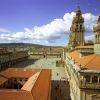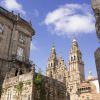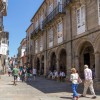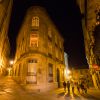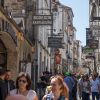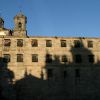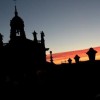- Accede I
- Regístrate I
- carrito
Plaza de Cervantes
La Plaza de Cervantes era conocida en el siglo XII como el “Foro”, por ser punto de reunión popular y el lugar donde el pregonero leía los acuerdos municipales y las ordenanzas del Arzobispo. Por esta vocación informativa, una de sus calles, de importante actividad comercial, se denomina “del Preguntoiro ”. Hace esquina con el edificio levantado en 1682 para el antiguo Ayuntamiento , que ocupó el solar durante 200 años, desde 1583 hasta su traslado en 1787 al Palacio de Raxoi. Hoy es el único edificio municipal barroco que se conserva intacto en Galicia. Una restauración interior ha permitido identificar las antiguas escribanías, el oratorio, el archivo y las mazmorras: se sabe que en la plaza llegaron a realizarse autos de fe en tiempos de la Inquisición y que en ella estuvo situado hasta 1570 el rollo o columna en torno a la cual se impartía justicia y a cuyo pie se situaba el patíbulo. La columna venía de presidir ejecuciones en el Monte de la Almáciga y pasó a la carballeira de Santa Susana, de donde desapareció en el siglo XIX.
Posteriormente, al especializarse en la venta de alimentos y mercancías, el espacio adquirió el nombre de “Plaza del Campo” y categoría de mercado principal. Esto explica también el nombre de la iglesia de San Bieito do Campo , cuyas líneas neoclásicas actuales no hacen pensar que la fundación se remonta al siglo X.
Trasladado el mercado a la Plaza de Abastos a finales del siglo XIX, la plaza adquirió el nombre definitivo de Cervantes. Un busto del escritor corona la fuente y nos recuerda que el autor de “Don Quijote” era portador de dos apellidos de origen gallego: Cervantes y Saavedra.
Casa da Troia
Por la rúa da Troia se llega a la casa del mismo nombre, una antigua pensión de estudiantes inmortalizada por Pérez Lugín en su novela homónima, escrita en 1915. Este escenario de las aventuras y desventuras de la vida universitaria del siglo XIX fue transformado en museo por la Asociación de Antiguos Tunos de Santiago, deseosos de revivir la atmósfera de la popular pensión regentada por Doña Generosa.
La calle desemboca en la plaza de San Miguel dos Agros , cuya iglesia fue fundada en el siglo X y reconstruida en los siglos XV, XVIII y XIX. En el lado opuesto de la calle se encuentra la Casa Gótica , también conocida como Casa del Rey Don Pedro, una de las escasas muestras de arquitectura civil gótica de la ciudad. En su interior, el Museo de las Peregrinaciones da constancia del fenómeno de las peregrinaciones a través de colecciones de pintura, escultura, orfebrería y artes populares.
En dirección contraria, la plaza de San Miguel conecta con la de San Martiño Pinario, dominada por la fachada de la iglesia de este imponente monasterio.
Iglesia de San Martiño Pinario
Construida desde finales del siglo XVI, su fachada, trazada en 1652, está concebida como un altar pétreo. Lo presiden la Virgen , San Benito y San Bernardo, mientras que en el frontón superior está San Martín partiendo su capa con un pobre. El campanario y la escalinata barroca son dos imágenes características del edificio, cuyas torres no sobrepasan la altura de la fachada debido a la oposición del cabildo catedralicio, que temía que compitiesen con las de la catedral.
Para acceder al templo debe pagarse una módica entrada que permite contemplar el fastuoso retablo mayor, diseñado por Fernando de Casas y Novoa y ejecutado por Romay, que está considerado uno de los mejores del Barroco español. La sillería del coro, situada detrás del altar Mayor, fue realizada en nogal por Mateo de Prado, entre 1639 y 1646, y también está reconocida como la más importante en Galicia.
Convento de San Francisco
Por la rúa da Porta da Pena -cuyo nombre recuerda una de las salidas de la muralla urbana- y la Costa Vella se puede llegar hasta el convento de San Francisco . La tradición atribuye su fundación al propio santo de Asís, que habría peregrinado a Compostela en 1213-1215. Aquí habría recibido una revelación divina para erigir un monasterio en terrenos de San Martiño Pinario. La financiación del proyecto se habría hecho con un tesoro que encontró el carbonero Cotolay en una fuente. El convento actual es del siglo XVII y la iglesia, del siglo XVIII. El monumento a San Francisco fue realizado por el escultor Francisco Asorey en conmemoración del séptimo centenario franciscano en 1930.
De vuelta hacia la Plaza del Obradoiro por la calle de San Francisco -lugar de paso continuo de las excursiones organizadas que acceden a la ciudad por la avenida de Xoán XXIII -emergen la Facultad de Medicina y el largo muro lateral del Hostal de los Reyes Católicos.










